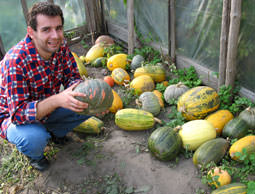
 Courtesy iStockphoto/Thinkstock The Beginning Farmer and Rancher Development Program, which provides training for new farmers, could be put on hold until after 2013 if changes aren’t made to Farm Bill 2012. |
The plight of two major sources of USDA grant funding for small-scale and sustainable farmers—the Beginning Farmer and Rancher Development Program and the Value-Added Producer Grant—are dependent on Congress’ Farm Bill 2012 decision to be made in the coming weeks. While BFRDP funding could be put on hold for more than a year, the funding proposed for VAPG has significantly decreased from past years.
Beginning Farmer and Rancher Development Program
In the past four years, BFRDP, which is administered by the USDA’s National Institute of Food and Agriculture, has invested more than $70 million in new-farmer training programs across the U.S. and has funded 145 projects in 46 states. The latest round of grants for this program, totaling $18 million, was authorized in the current Farm Bill cycle and will expire on Sept. 30, 2012. Unless Congress reauthorizes the Farm Bill or provides a short-term extension of the current Farm Bill that explicitly provides for new BFRDP funding, the program could completely vanish for at least one year.
The BFRDP provides the training and tools the next generation of farmers needs to be successful. The program supports financial and entrepreneurial training, risk-management education, mentoring and apprenticeship programs, innovative farm-transfer and -transition practices, and other educational activities to assist beginning farmers and ranchers across the country. The BFRDP is especially targeted to collaborative local, state and regional networks and partnerships.
“The future of American agriculture depends on cultivating the next generation of farmers and ranchers,” says Juli Obudzinski, policy associate with the National Sustainable Agriculture Coalition. “BFRDP is the only federal program dedicated to training new farmers. Over the past four years, the program has funded a wide variety of successful initiatives to help new farmers start a career in agriculture.”
Agriculture Secretary Tom Vilsack has stressed the importance of supporting the next generation of farmers and has repeatedly issued a national challenge to create 100,000 new farmers. In the first year of the BFRDP alone, USDA funded projects that supported training for 5,000 new producers, and in 2011, grants supported training for more than 30,000.
For Fiscal Year 2012, $18 million was awarded to support projects in 27 states. Of the 40 grants that were announced, six were awarded to member organizations of the NSAC, including Dakota Rural Action (South Dakota), Food System Economic Partnership (Michigan), Future Harvest-Chesapeake Alliance for Sustainable Agriculture (Maryland; award to University of Maryland), Growing Power (Wisconsin), Land Stewardship Project (Minnesota, for work in 14 states), and Women, Food and Agriculture Network (Iowa, for work in Iowa and Nebraska).
Value-Added Producer Grants
Also a Farm Bill program, VAPG is up for renewal in the 2012 Farm Bill. To date, both the Senate-passed and House committee-passed Farm Bills renew VAPG and both would provide it with $50 million in total new mandatory funding for the next five years.
Value-Added Producer Grants award funding to producers to help them develop farm-related businesses that add value to basic agricultural products through processing, product differentiation, commodity segregation, on-farm energy production, labeling and certification, and local and regional food marketing.
“We applaud Congress for renewing VAPG in the new Farm Bill it is debating,” says Helen Dombalis, NSAC policy associate. “The funding level proposed in both bills; however, is only half of the historic VAPG funding levels. We hope that the total funding level is doubled to $100 million for the next five years in the final version of the Farm Bill. That would be a surefire way to accelerate economic recovery, create long-term sustainable income streams for farmers and farming communities, and meet consumer demand for high-quality agricultural products.”
The NSAC recently released a free downloadable Farmers’ Guide to Value-Added Producer Grant Funding on the heels of the USDA’s announcement of $14 million in available funds for fiscal year 2012 for Value-Added Producer Grants. The guide, available for free download online, includes clear information on new program rules and contains a step-by-step description of the application and ranking processes, with helpful hints to improve a producer’s chances of obtaining funding from the highly competitive program. It also describes the program priorities for small and medium-sized family farms, beginning farmers and ranchers, socially disadvantaged farmers and ranchers, and mid-tier value chains (regional supply networks with active farmer participation).
“This program is one of the best USDA programs for boosting farm income, creating new job opportunities and aiding rural economic renewal,” Dombalis says. “We know farmers and ranchers across the country have been anxiously waiting for this year’s VAPG funding announcement and are confident that NSAC’s resource guide will be useful in assisting first-time and seasoned applicants alike.”
Applications for VAPG are due at USDA Rural Development state offices by Oct.15, 2012.




